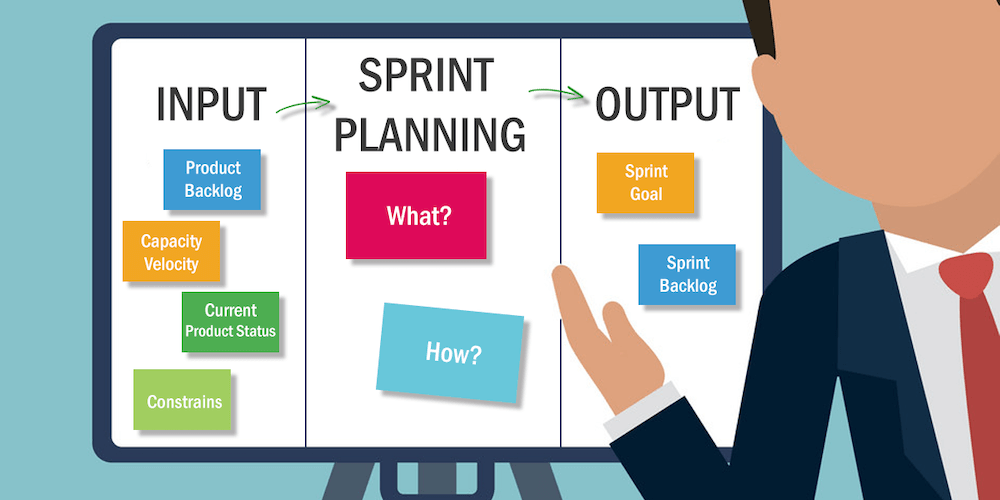Sprint is a common terminology in Scrum, one of the agile variants for project management. A sprint is a short phase in which a certain set of work is implemented. And agile sprint planning plays a key role in guaranteeing team members reach their predefined objectives in each iteration. In this article, Designveloper will give you an overall insight into why this event is important and how to execute it productively.
You should know this before knowing about agile sprint planning: What is Agile Software development?
What is Sprint Planning?

Sprint planning is a kick-off event of a sprint. In the Scrum framework, smaller parts of a whole project are conducted within short periods. So, team members need to hold a short-lived meeting to determine:
- Sprint objective
- How long the sprint lasts
- Which product backlog items (also known as “user stories”) can be completed in the sprint
- How the work will be executed
Agile sprint planning requires the collaboration of a product owner, a scrum master, and technical members. They all work together to establish priorities and the agenda of work to achieve those features.
Good sprint plans help Scrum team members to have a transparent, motivating environment to get jobs done well. Otherwise, ineffective sprint plans can drive a whole team out of the right track due to infeasible expectations, overwhelming workload, and unsuccessful communications. That’s why this event is worth focusing on and helps decide whether your team has a good start.
Expected Advantages and When to Apply Sprint Planning

After team members wrap up the review and retrospective of the previous sprint, they will start the next iteration with sprint planning. Its primary advantage is it enables members to understand what is valuable for the product owner and forecast what can be done first.
This event gives a whole team opportunities to plan how they conduct the work. Concurrently, it allows team members to contribute to planning discussions and strengthen their interpersonal connections.
Sprint planning is widely applied in the Scrum development workspace. But other traditional agile teams can hold the session right at the beginning of each iteration. Therefore, this term is interchangeably used with iteration planning for those applying a timeboxed methodology to manage projects. Having said that, teams adopting flow-based management solutions can organize similar events to identify which items should be placed on the top priorities.
FURTHER READING:▶ Agile Software Development Life Cycle Guide
▶ Pros and Cons of Agile Methodology: Which Team Should Apply This Model
▶ 12 Agile Principles and How It Looks in Practice
▶ The Agile Mindset: What do you need to focus on?
Common Problems Faced in Agile Sprint Planning
Sprint planning is considered an important event that significantly affects the productivity of a whole team in the sprint.
But there are several problems your team may confront during the session. These issues can make sprint planning ineffective, hence resulting in the team’s poor performance and failure of achieving required product backlog items.

These pitfalls include:
- The product owner and stakeholders don’t make user and business expectations clear to team members. So the latter has little or no understanding of what the former truly wants. This possibly makes them build the improperly refined product backlog to pick ready-state items.
- The product owner and stakeholders only focus on large-size user stories instead of breaking them down.
- A team has no clear sprint goals or arranges a set of irrelevant and unimportant work. This can derail a project and make team members feel like making no progress in work.
- Development team members have no experience or proper understanding of the product owner’s requirements. In other words, they can focus too much on how to make user stories done rather than learn to understand them first. Not to mention that only experienced members proactively contribute to the discussion during sprint planning. Lack of communication can lead to mistakes in estimating a user story’s size and forecasting the workload in one sprint.
- Team members fail to organize product backlog items reasonably in priority order.
- The product owner only showcases his/her ideas from business perspectives. Meanwhile, development team members need to analyze such ideas from technical perspectives to help build optimal user stories. Failure to do so possibly translates to failure to draw out suitable features for a viable deliverable.
How does Sprint Planning Works?
A typical sprint averagely lasts from 2 to 4 weeks. Accordingly, scrum teams are capable of conducting a sprint planning session effectively within one hour or two. According to the Scrum Guide, the maximum timebox for this event can be 8 hours if teams have a one-month iteration.
The agile sprint planning session can be held in the team room. This is where people gather and update all essential information for the product backlog through information radiators.

In this section, Designveloper will elaborate on how our team members normally work in sprint planning. This session entails two parts as follows:
Scope
Team members discuss and finalize which user stories from the prioritized list they are able to accomplish in the sprint. However, before giving such an informed conclusion, the team has to solve the following questions:
- What is the ultimate goal of the sprint?
- Which product backlog items are in a ready state and have the potential to help the team work toward the goal?
- Who will get involved in the team?
- What is the team’s competence?
- Which items need to come first according to the predefined goal and the team’s capabilities?
- How confident are team members about completing items during the sprint?
Plan
Once the team has identified the scope of the sprint, they will go further to how the chosen user stories will be delivered. More particularly, the team determines certain tasks to complete those items and finds out possible dependencies or relationships between items. Beyond that, the team starts allocating responsibilities and roles to the right staff so that they can work well toward the common goal.
Important Tips to Conduct Effective Sprint Planning
The sprint planning session will become ineffective if team members have poor discussions and misunderstandings of business ideas or user stories. So learning to conduct the productive session is a must to avoid the common pitfalls Designveloper mentioned above. Below are some of what your team should do to ensure the effectiveness of agile sprint planning:
Recommended reading: 6 Agile Project Management Tools That You Should Know in 2022
Make a Thorough Preparation for Sprint Planning Meetings
To run a successful sprint planning meeting, team members should be well-prepared and disciplined. Right before the session, team members congregate lessons and stakeholders’ feedback from the previous sprint retrospective to set the scene for the next sprint.

Importantly, the product owner needs to update and build a clearly refined product backlog through backlog refinement. This process is optional, but it’s more advisable for team members to review the backlog to ensure its clarity and transparency. If your team has a two-week sprint, for example, you should hold a refinement session in the middle of the sprint. This process not only helps your team prepare for the next sprint planning. But it also enables you to look back at the current work from different angles.
Team members can use the INVEST method to write effective user stories. Further, they should communicate and constructively discuss to determine the sprint goal, the scope of user stories, and their priorities. A careful prep can translate to effective sprint planning, which encourages team members to work more productively and guarantees other upcoming sprint stages run well.
Identify a Time for Sprint Planning
Spending too much time on agile sprint planning may exhaust the whole team and navigate them away from the main focus. Therefore, the maximum time, also known as “timebox”, should be two hours per one-week sprint. This means, if the sprint lasts three weeks, you should spend no more than six weeks on sprint planning.
Focus on Outputs, not the Whole Work
As Scrum and other agile methodologies are ongoing processes, you can’t plan everything in advance. So sprint plans shouldn’t be too detailed. But they are rather just enough for team members to know how other following steps will take place. This means your team should focus on valuable outcomes, rather than which tasks should be prioritized and how long they take.

The nature of agile methodologies also makes you hardly receive all information right at the beginning of the sprint to make detailed plans. Nor does it stop you from identifying all possible problems you may encounter during the sprint.
But you shouldn’t let this trait direct you to ambiguous plans. If you don’t know something, you should frame it, ask a question around it and find the answer during the sprint. Moreover, it’s advisable to apply user stories to envision the work from customer perspectives. This helps identify issues a customer is confronting and propose improvements he/she is finding.
Beyond that, you can add measurable results to user stories. This makes your outcomes more measurable and transparent.
Estimate Your Team’s Capability and Resource
Wrong estimations of how much work can be done during the sprint can leave negative implications. Apart from work failures, team members may confront demotivation and waste of resources, albeit finance or human. Therefore, Designveloper encourages your team to adopt estimation techniques (e.g. t-shirt sizing or story points) to better understand what members can or cannot do.
Inevitably, those making good estimations need a trust-based workspace where they have leeway to exchange and discuss information. This environment encourages them to make positive contributions, continuously learn and improve products as well as their working process.
Conclusion
Sprint planning is a critical event that lays a solid foundation for other work during the iteration. However, without thorough preparation and effective exchanges between parties, the agile sprint planning session cannot be held productively. Also, there’s no perfect plan. So it shouldn’t be your team’s burden or hurdle that contains too many superfluous details and moves members away from valuable outputs. Focusing on the sprint goal and planning enough for the backlog are other essential things Designveloper is applying and hence encourages you to do.
The post Agile Sprint Planning: Definition and Generic Guides in 2022 appeared first on Designveloper.
March 07, 2022 at 11:00AM












No comments:
Post a Comment